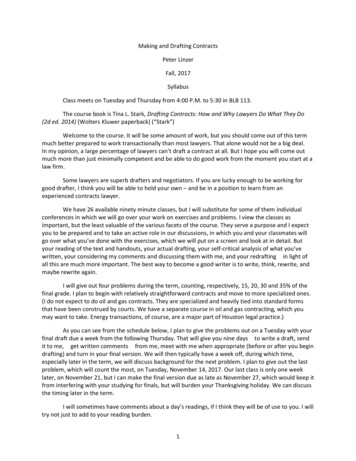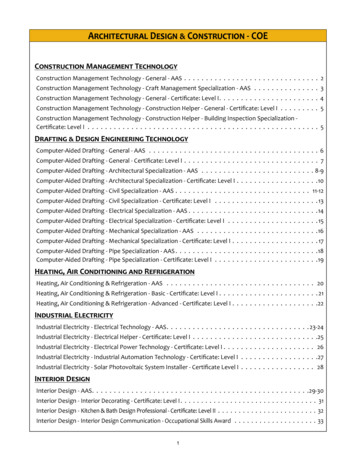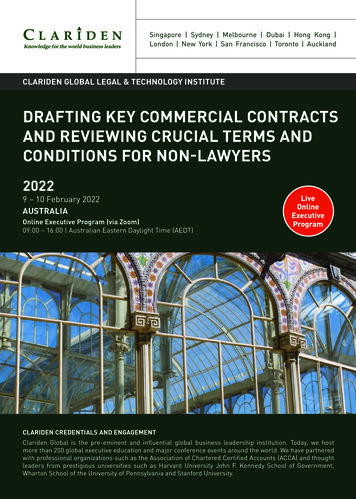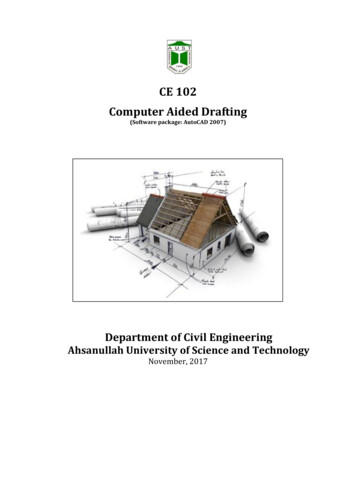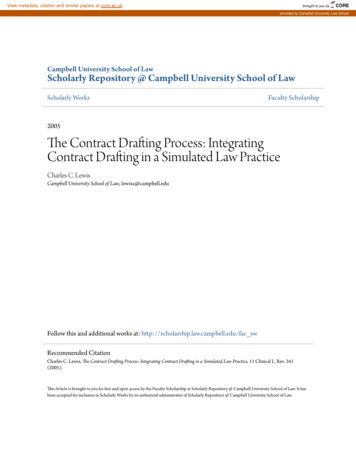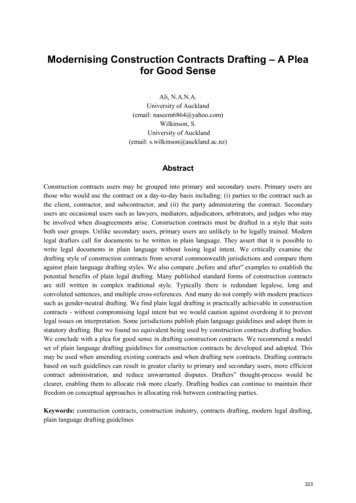
Transcription
Modernising Construction Contracts Drafting – A Pleafor Good SenseAli, N.A.N.A.University of Auckland(email: naseem6864@yahoo.com)Wilkinson, S.University of Auckland(email: s.wilkinson@auckland.ac.nz)AbstractConstruction contracts users may be grouped into primary and secondary users. Primary users arethose who would use the contract on a day-to-day basis including: (i) parties to the contract such asthe client, contractor, and subcontractor, and (ii) the party administering the contract. Secondaryusers are occasional users such as lawyers, mediators, adjudicators, arbitrators, and judges who maybe involved when disagreements arise. Construction contracts must be drafted in a style that suitsboth user groups. Unlike secondary users, primary users are unlikely to be legally trained. Modernlegal drafters call for documents to be written in plain language. They assert that it is possible towrite legal documents in plain language without losing legal intent. We critically examine thedrafting style of construction contracts from several commonwealth jurisdictions and compare themagainst plain language drafting styles. We also compare „before and after‟ examples to establish thepotential benefits of plain legal drafting. Many published standard forms of construction contractsare still written in complex traditional style. Typically there is redundant legalese, long andconvoluted sentences, and multiple cross-references. And many do not comply with modern practicessuch as gender-neutral drafting. We find plain legal drafting is practically achievable in constructioncontracts - without compromising legal intent but we would caution against overdoing it to preventlegal issues on interpretation. Some jurisdictions publish plain language guidelines and adopt them instatutory drafting. But we found no equivalent being used by construction contracts drafting bodies.We conclude with a plea for good sense in drafting construction contracts. We recommend a modelset of plain language drafting guidelines for construction contracts be developed and adopted. Thismay be used when amending existing contracts and when drafting new contracts. Drafting contractsbased on such guidelines can result in greater clarity to primary and secondary users, more efficientcontract administration, and reduce unwarranted disputes. Drafters‟ thought-process would beclearer, enabling them to allocate risk more clearly. Drafting bodies can continue to maintain theirfreedom on conceptual approaches in allocating risk between contracting parties.Keywords: construction contracts, construction industry, contracts drafting, modern legal drafting,plain language drafting guidelines323
1. Introduction1.1 Construction contractsConstruction contracts form the basis of contractual relations among parties to construction projects.They include (i) main or head contracts between clients and contractors, and (ii) subcontractsbetween contractors and subcontractors or between subcontractors and sub-subcontractors. Thesecontracts, particularly the main or head contracts are commonly based on published standard terms ofconstruction contracts.1.2 Primary and secondary users of construction contractsMany of the standard terms of contracts provide for the contract to be administered by a third party.In this paper we refer to the third party generically as contract administrator.The parties to the contract and the contract administrator form the core people that would use thecontract on a day-to-day basis. We call them the primary users. It is important that the parties to thecontract fully understand the contract including their rights and obligations under them. Equallyimportantly, the contract administrator must understand and administer the contract based on theexpress provisions of the contract and what may be implied in law. An important example of animplied term imposed on a contract administrator - whether or not expressly stated in the contract - isthe obligation (when exercising certain decision-making functions like certification of payment) toadminister the contract in a fair and independent manner.1Whilst the contract administrator would usually have some construction related background and isexpected to have sufficient knowledge of construction contracts and aspects of construction law, thecontract administrator is not expected to be (and is usually not) legally qualified.If disagreements arise under the contract and they evolve into a formal dispute, others like lawyers,claims consultants, party representatives, mediators, adjudicators, arbitrators, or judges may beinvolved. We call them secondary users. Secondary users are occasional users who are only involvedwhen there are disputes to be resolved. They are usually interested in the legal interpretation of thecontract.1Canterbury Pipe Lines Ltd v Christchurch Drainage Board [1979] 2 NZLR (CA)324
1.3 Construction contracts and drafting styleConstruction contracts must be drafted to serve both primary and secondary users‟ needs. They mustbe clear enough for the contract administrator and parties to the contract to understand their duties inadministering the contract and their rights and obligations under the contract. And they must becapable of clear contractual interpretation if a dispute arises.The drafting styles to cater for the needs of these two groups of users‟ need not be different. Somecontracts are drafted in traditional legalese, and have explanatory notes or guides in plain language.The assumption here may be that it is not possible to effectively express legal concepts in plainlanguage. Butt (2005) dispels this as a myth, and goes further in suggesting that plain legal languageeven saves money. He says there is now over 20 years of research on the topic of plain language inlaw. He encourages the construction industry to consider using plain language and reassures:The evidence is overwhelming. Plain legal language brings substantial benefits. It wouldbring those benefits to the construction industry. Carefully used, plain language is legally safe;it saves time and money; lawyers and non-lawyers alike have a better chance of understandingit; and most judges prefer it. (Butt 2005, p.9)Thus plain language should be seriously considered when drafting construction contracts.2. Modern plain legal drafting2.1 What is plain language?Before analysing and considering the use of plain language, we must first ask what plain language is.Much has been written about plain language and plain legal language. See for example Eagleson(1990), Garner (2001), Asprey (2003), Cutts (2004), Painter (2005), Kimble (2006), Butt and Castle(2006), and Adler (2007). In essence plain language means writing that is „clear and effective for itsintended audience‟ (Butt and Castle 2006, p.113) and writing that is straightforward, and „avoidsobscurity, inflated vocabulary and convoluted sentence structure‟ and „using only as many words asare necessary‟, (Eagleson 2010). All these make it easier for the audience to understand what thewriter intended.Garner suggests the fundamental principle is that „anything translatable into simpler words in thesame language is bad style.‟ He defends this strict principle, by saying „that may sound like a facileoversimplification that fails when put into practice – but it isn‟t and it doesn‟t.‟ (Garner 2001, p.662).325
2.2 Modern legislative drafting guidelinesIn support of modern plain legal language there are now legislative drafting guidelines whichadvocate plain legal drafting. See for example the New Zealand‟s Parliamentary Counsel Offices‟(PCO) drafting guideline (Parliamentary Counsel Office 2009) and Australia‟s Office ofParliamentary Counsel Plain English Manual (Office of Parliamentary Counsel 2003). Rule 3.12 ofthe New Zealand PCO drafting guideline (Parliamentary Counsel Office 2009, p.5) instructs, amongothers: Use the simplest word that conveys the meaningEliminate unnecessary wordsDo not use archaic languageAlways use gender-neutral languageAustralia‟s Office of Parliamentary Counsel‟s Plain English Manual states their aim of plain Englishdrafting in Chapter 1, Paragraph 10: „to simplify all official writing by removing unnecessaryobscurity and complexity‟ (Office of Parliamentary Counsel 2003, p.5). Their commitment to plainEnglish takes a wide approach in Paragraph 11: „The Office policy is to draft in plain English, but todo more than that. It is to develop a whole art of making laws easy to understand‟ (Office ofParliamentary Counsel 2003, p.5).These statutory drafting guidelines are comprehensive. We did not find any comparable plainlanguage drafting guidelines published by any of the construction contracts drafting bodies.2.3 Common traits of modern plain languageIn addition to plain language parliamentary drafting office guidelines, many modern legal writersadvocate various plain language guidelines. For example, Painter (2005) lists 40 „rules‟ in his bookThe Legal Writer: 40 Rules for the Art of Legal Writing. There are many common traits suggested byplain language experts. We list below a small selection of some of them.2.3.1 Average sentence lengthPlain language experts suggest sentence length should be around 20 words per sentence. For example,Painter (2005, p.66) suggests an average of 18 or fewer. This is the suggested average. Sentencescould have more than 20 words – if it communicates clearly. Raj et al analysed and concluded that theaverage length of sentence in the FIDIC White Book has increased from 32 in the 1990 edition to 34 in the2006 edition. They then acknowledge that „most style guides recommend much shorter sentencesbecause it is widely accepted that shorter sentences are easier to understand.‟ (2009, p.218). Eveninstructions to authors of quality journals such as the Construction Management and Economicssuggest simple, short sentences make better communication (Construction Management and326
Economics, 2010): „Simple language, short sentences and a good use of headings all help tocommunicate information more effectively.‟The easiest way of reducing the average words per sentence is to break up long sentences into shorterones using the period or full stop. Listing and the use of numbering also help break up sentences topresent them more effectively. Long sentences make reading difficult. Berry (2009, p.38) explains:One of the major reasons why readers of legislative documents have difficulty inunderstanding them is that long and complex sentence structures overtax the cognitivecapacity of the short-term memory.2.3.2 LegalismAll modern legal drafters suggest legalism such as whereas, hereinbefore, hereinafter, desirous, said,and the said are unnecessary. Some suggest redundant doublets be omitted, for example, Butt andCastle (2006, p.27) suggest void alone will do instead of null and void – except possibly if used inbijural countries such as Canada.Other phrases to be avoided include „subject always‟, „provided always‟ and „and/or‟. These phrasesare not straightforward and require readers to undertake some analysis before the clause could beunderstood.Genuine „terms of art‟ may of course be maintained, but these are generally only few. One study of areal-estate sales agreement by Benson Barr, George Hathaway, Nancy Omichinski and Diana Pratt,„Legalese and the Myth of Case Precedent‟ (1985) 64 Michigan Bar Journal 1136-1137, quoted inKimble (2006, p.11) found that only about 3% of the words had significant legal meaning based onprecedent. In construction contracts this is estimated to be much less than 3% (Ameer Ali, 2008b,p.16). He suggests a few possible terms of art in a construction contract: „reasonable skill and care,fitness for purpose, collateral warranty, regularly and diligently, time is of the essence, practicalcompletion, liquidated damages, bills of quantities, provisional sums, loss and expense, andtermination of the contractor‟s employment.‟2.3.3 Plainer words preferred over more complex wordsPlainer words are preferred over more complex words. For example: use is preferred over utilise,terminating or ending a contract is preferred over determining a contract.2.3.4 Consistent use of wordsWords should be used consistently, and preference should be given to words with a unique meaningover words with multiple meanings. The first part may be best expressed as: „Never change yourlanguage unless you wish to change your meaning, and always change your language if you wish tochange your meaning‟ (Aitken and Butt 2006, p.19), crediting Jeremy Bentham as originating this327
drafter‟s golden rule. For example, the word determination has multiple meanings, so termination orending is preferable when used in the context of bringing a contract to an end.Shall is commonly used throughout traditionally drafted construction contracts. But shall is rarelyused in a consistent manner. Depending on context, shall has multiple meanings beyond meaning theimperative must. Modern legal writing experts have identified many more meanings of shall. Forexample, in addition to must and may, Butt and Castle (2006, pp.131-132) identify shall to meangiving a direction, stating circumstances, negating a right or duty, expressing an intention, stating acondition precedent, or stating a condition subsequent. In writing about avoiding shall, Garner (2001,p.939) suggests a word that has multiple meanings, even in midsentence, „runs afoul of several basicprinciples of good drafting‟. Professor Kimble (Kimble 2006, p.159) is more direct and concludes,„give shall the boot‟. Their advice, paraphrased in my words: shun shall.2.3.5 Redundant parenthetical numeralsOmit redundant duplication through parenthetical numerals like fourteen (14). With the advent ofprinted and typed text, this practice serves no purpose. Worse still the words and numbers could be inconflict - leading to unnecessary legal arguments.2.3.6 Multiple cross-referencingCross-referencing may be inevitable in long and complex contracts but multiple cross-referencingshould be limited. This might sometimes mean inferring interpretation from reading the contract as awhole or repeating contractual provisions. Whilst plain language often results in shorter documentsthan those written in traditional legal language, clarity should take priority over brevity. Anappropriate balance would serve the parties best.2.3.7 Active and passive sentencesActive sentences get the message across more directly and efficiently using fewer words. „Thecontractor must submit a programme‟ is written in active style and is more direct and uses six words.„A programme must be submitted by the contractor‟ is written in passive style and has eight words(33% more than the active style). When writing on reducing complexity of legislative drafting, Berry(2009, p.68) discusses the use of active and passive sentence structures then concludes:In sum, the research suggests that legislative counsel should, as a general rule, draftlegislative documents in the active voice. Writing experts and research studies both support thegeneral value of active sentences for understanding.2.3.8 Gender-neutral draftingIn addition to the actual style of words, proponents of modern plain language suggest documentsshould be written in line with modern approaches and structured for ease of reading andcomprehension. Among these would be gender-neutral drafting. The least preferable way to achieve328
this is to use he or she, his or her, him or her, or she or he, her or him, or her or him. Using the plural,rewording in the passive, and repeating the noun enable gender-neutral drafting without thecumbersome he or she.2.3.9 Lists and numberingUsing listing and numbering helps break paragraphs into more readable shorter sentences.2.3.10 Headings, sub-headings, font type, font size, and use of white spacesThe use of headings, sub-headings, appropriate font type and size and white space around paragraphscan all make an impact on readability.3. Applying modern plain legal drafting style to publishedstandard construction contractsIn this section, we have taken examples from published standard terms of construction contractsfound in several commonwealth jurisdictions, and discuss the application of plain language toconstruction contracts. We do this by comparing examples of traditional drafting with re-drafts andthrough examples from contracts that are in plain language.3.1 Joint Contracts Tribunal (JCT) contractsThe most recent suite of the JCT contracts published in the UK has had much publicity. Showcasingprojects between GBP 40 million and GBP 80,000.00, it has been referred to as being versatile (JCT2010a, p 1). Neil Gower, chief executive of JCT claims „JCT has been setting the standard inconstruction contracts for almost 80 years‟ and that they continue to „strive to ensure‟ the contractsare „up-to-date‟ (JCT 2010b).The JCT Standard Building Contract (JCT 2007a) has been said to be the “ „industry standard‟against which all others are measured” (Murdoch and Hughes, 2008, p 106). A survey of contractsused in 2007 (RICS, 2007, p 13) showed the JCT contracts were used on 79.3% of the number ofprojects from the respondents to a survey. This was followed by the New Engineering Contract(7.7%) and GC/Works contracts (6.1%).Historically many other jurisdictions such as Hong Kong and Malaysia had used the earlier JCTdocuments as a base, but which have now conceptually evolved in their own ways. The traditionaldrafting style has however generally remained.The JCT revisions over the years have focused on addressing the way risks are allocated between theparties and how up-to-date technical provisions are incorporated in the contracts. In addition, therehas been some refinement on the drafting style. For example, the word „determination‟ which has329
multiple meanings has now been replaced with „termination‟ and the phrase „extension of time‟ hasnow been rephrased „adjustment of time‟ as the duration for completion could be reduced. Much ofthe drafting style is however still traditional and not in plain English. Consider, for example, thefollowing.3.1.1 JCT Standard Building ContractClause 4.14 from the JCT Standard Building Contract (Joint Contracts Tribunal 2007a, p.53) reads:Without affecting any other rights and remedies of the Contractor, if the Employer, subject toany notice issued pursuant to clause 4.13.4, fails to pay the Contractor (including any VATproperly chargeable in respect of such payment) by the final date for payment as required bythese Conditions and such failure continues for 7 days after the Contractor has given to theEmployer, with a copy to the Architect/Contract Administrator, written notice of his intentionto suspend the performance of his obligations under this Contract and the ground or grounds onwhich it is intended to suspend the performance, then the Contactor may suspend suchperformance until payment in full occurs.This is a 112-word sentence with a Flesch Reading Ease score of 0. Whilst it can be understood afterseveral reads, by re-drafting and re-arranging the clause and using listing or numbering, readabilityimproves. Consider this re-draft:4.14.1Subject to any notice issued by the Employer under clause 4.13.4, if the Employer failsto pay the Contractor (including any VAT chargeable), by the final date for paymentunder these Conditions, then the Contactor may suspend performing his obligationsunder this Contract until full payment is made, if:4.14.1.1 the Contractor has given to the Employer written notice of his intention tosuspend performing his obligations under this Contract, with a copy to theArchitect/Contract Administrator;4.14.1.2 the Contractor has stated the appropriate grounds in the notice; and4.14.1.3 such failure continues for 7 days after the Contractor‟s written notice.4.14.2The Contractor‟s other rights and remedies are not affected.The total number of words has decreased only slightly but clarity has improved – at least on thesentence structure and the Flesch Reading Ease score (now 7.2). If this were accepted as having thesame meaning as the original, then the re-draft serves the intended primary audience better.These improvements were achieved by applying only some of the modern legal drafting guidelines. Acomplete review would see the clause drafted in gender-neutral style without any reference to „his‟and the longish Architect/Contract Administrator shortened to just one or two words omitting the330
virgule or slash (/) but maintaining legal intent through appropriate definitions in the definitionssection or the articles of agreement. This can be done assuming there are no extrinsic reasons such as„political‟ or diplomatic reasons for maintaining the term „Architect/Contract Administrator‟throughout the entire contract. The cumulative effect of using these modern drafting styles when redrafting across the entire contract can be significant.3.1.2 JCT Design and Build ContractThere are other similar examples that could be given from within the JCT suite. The survey ofcontracts in use in 2007 (RICS, 2007, p.19) suggests Design and Build contracts take up a significantportion of market share as a procurement route, and the JCT Design and Build contract accounts for19% of all contracts used and „the proportion by number is the highest figure ever recorded‟. Givenits relative popularity, we have taken our next example from the JCT Design and Build contract.We chose clause 2.17.1 on design work liability for two reasons: (i) this is a major distinguishingfeature from the traditional contracts, and (ii) the 134-word sentence typifies similar design liabilitydrafting style in other standard terms of construction contracts within the UK and far beyond such asthe those found in Malaysia. The similarity of these clauses reflects the „boilerplate‟ or cut-and pasteapproach that is common in construction contracts drafting. It also shows modern drafting styleguidelines are rarely used when drafting construction contracts.Clause 2.17.1 (Joint Contracts Tribunal 2007b, p.32) reads:Insofar as his design of the Works is comprised in the Contractor‟s Proposals and in what theContractor is to complete in accordance with the Employer‟s Requirements and theseConditions (including any further design required to be carried by the Contractor as a result ofa Change), the Contractor shall in respect of any inadequacy in such design have the likeliability to the Employer, whether under statute or otherwise, as would an architect or, as thecase may be, other appropriate professional designer holding himself out as competent to takeon work for such design who, acting independently under a separate contract with theEmployer, has supplied such design for or in connection with works to be carried out andcompleted by a building contractor who is not the supplier of the design.This has 134 words in a single sentence, and has a Flesch Reading Ease score of 0. The equivalentdesign obligation clause found in clause 10(2) Alternative A of the GC/Works/1 Single Stage Design& Build contract (Property Advisers to the Civil Estate 1998, p.19) and that found in clause D1(b)under option module D of the CIDB contract (Construction Industry Development Board Malaysia2000, p.107) are similar in style.The essence of clause 2.17.1 (and the equivalent in the GC/Works/1 and CIDB contracts) is:The Contractor owes a reasonable skill and care obligation for design, as would a professionalappointed independently. [17 words]331
That has been the intended meaning for decades – since the Bolam2 days, but the JCT clause stopshort of making plain what the current standard of care for design is. The NZIA Standard Conditionsof Contract (New Zealand Institute of Architects 2009, p.16) stipulates a similar design obligation in14 words (and a Flesch reading Ease score of 41.5) in the first part of clause 8.6.5:The Contractor must carry out all Contractor design with reasonable care, skill and diligence.It may be that the JCT contract drafters wanted to ensure the clause is flexible enough to cater forchanges in the standard for design obligation of professionals. Even if this flexibility were to bepreserved, the essence of the 134-word sentence can be captured in 23 words:The Contractor has the same liability to the Employer for design, as would any otherappropriate professional designer appointed separately by the Employer.Judges have long criticized the JCT contracts with strong words like ‟A farrago of obscurities‟3 andthat they contained among the most „obscurely and ineptly drafted clauses in the United Kingdom‟4.It appears, whilst the JCT has partly responded to some of these judicial criticism, there is a notableadvice that remains unheeded. Putting aside the accusation that it was „deviously drafted with what inparts can only be a calculated lack of forthright clarity‟ Sachs LJ suggested in the Bickerton case:The time has come for the whole to be completely redrafted so that laymen – contractors andbuilding owners alike – can understand what are their own duties and obligations and whatare those of the architect.‟5We would however caution against overdoing to prevent loss of legal intent. For example: „theContractor must be careful when designing‟ does not carry the same legal meaning.Perhaps what needs to be done is to maintain the negotiated concepts and the technical refinementsfound in the current JCT contracts that have been introduced over the years, but to re-draft thecontract in plain English, heeding modern legal drafting styles - some of which are highlighted in this2Bolam v Friern Hospital Management Committee [1957] 1 WLR 582, CA3English Industrial Estates Corporation v George Wimpey & Co Ltd [1973] 1 Lloyd‟s Rep 118, CAat 1234Peak Construction (Liverpool) Ltd v McKinney Foundations Ltd [1970] 1 BLR 111, CA at 1145Bickerton & Son Ltd v North West Metropolitan Regional Hospital Board [1969] 1 All ER 977, CAat 979332
paper. But that won‟t be easy. The creator of the Flesch Reading Ease himself, Rudolf Flesch, warns(Flesch 1979, p.2):Legalese is worse than smoking cigarettes. To kick the habit is extremely hard. So don‟t kidyourself. If you want to write plain English, you‟ll have to learn how. You‟ll have to study itas if it were Spanish or French. It‟ll take much work and lots of practice until you‟ve masteredthe skill.3.2 GC/Works/1 contractsApart from the dominance of the JCT suite of contracts, the survey of contracts used in 2007 (RICS,2007, p 13) shows the GC/Works contracts accounted for 6.1% of the total number of contracts. Thepublisher of the GC/Works contracts - the Stationery Office for the Property Advisors for the CivilEstate (PACE) did not refer to any plain language drafting guidelines used, but do make a claim onhaving adopted plain English for the suite of contracts. The PACE Information Note 26/99 (PropertyAdvisers to the Civil Estate, 1999, p.2) claims:The contracts are written in plain English and are accompanied by a comprehensivecommentary. This ensures that users are able to easily interpret and understand the generalconditions without the need to seek additional expensive legal advice.Consider the following two clauses in the light of the claim that the contracts are written in plainEnglish. Clause 8A(1) on professional indemnity insurance for design reads in a single 156-wordsentence (Property Advisers to the Civil Estate 1998, p.18):The Contractor shall maintain professional indemnity insurance covering (inter alia) allliability hereunder in respect of defects or insufficiency in design, upon customary and usualterms and conditions prevailing from the time being in the insurance market, and withreputable insurers lawfully carrying on such insurance business in the United Kingdom (in anamount not less than that required by the Abstract of Particulars) for any one occurrence orseries of occurrences arising out of any one event, for a period beginning now and ending 12years (or such other period as is required by the Abstract of Particulars) after certificationunder Condition 39 (Certifying completion) of the completion of the Works or the last Sectionthereof in respect of which completion is certified, or the determination of the Contract for anyreason whatsoever, including (without limitation) breach by the Employer, whichever is theearlier, provided always that such insurance is available at commercially reasonable rates.And clause 51 headed recovery of sums (Property Advisers to the Civil Estate 1998, p.47) is a 159word sentence:Without prejudice and in addition to any other rights and remedies of the Employer, wheneverunder or in respect of the Contract, or under or in respect of any other contract between theContractor or any other member of the Contractor‟s Group and the Employer or any other333
member of the Employer‟s Group, any sum of money shall be recoverable from or payable bythe Contractor or any other member of the Contractor‟s Group by or to the Employer or anyother member of the Employer‟s Group, it may be deducted by the Employer from any sum orsums then due or which at any time thereafter may become due to the Contractor or any othermember of the Contractor‟s Group under or in respect of the Contract, or under or in respect ofany other contract between the Contractor or any other member of the Contractor‟s Group andthe Employer or any other member of the Employer‟s Group.Both score 0 on the Flesch Reading Ease scale. And contrary to its claim of having adopted plainEnglish, neither clause can be said to comply with modern plain English drafting style suggested inthis paper. Both clauses are not easily understood on first reading.Such traditional drafting style is not unique to the United Kingdom. They are also found in othercommonwealth countries that adopted the original British construction procurement systems. Hereare some examples from Singapore.3.3 Singaporean contracts3.3.1 Singapore buildi
language drafting guidelines published by any of the construction contracts drafting bodies. 2.3 Common traits of modern plain language . In addition to plain language parliamentary drafting office guidelines, many modern legal writers advocate various plain language guidelines. For example, Pai
